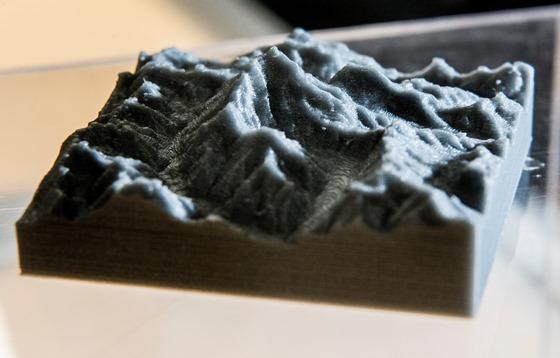 It is becoming increasingly challenging to discover areas in which 3D printing is not making a contribution. In yet another demonstration of the technology’s capacity to assist in human efforts, Dr. Timothy Whitehead of De Montfort University in Leicester has put it to use in support of a project designed to help reduce loss of life resulting from landslides in Peru.
It is becoming increasingly challenging to discover areas in which 3D printing is not making a contribution. In yet another demonstration of the technology’s capacity to assist in human efforts, Dr. Timothy Whitehead of De Montfort University in Leicester has put it to use in support of a project designed to help reduce loss of life resulting from landslides in Peru.
Heavy annual rains combined with the near vertical topography of the Andes regularly unleashes torrents of mud and rock into the towns and villages in the mountainous areas of Peru. These mudslides not only cause devastation to physical property but lead to multiple deaths each year. However present these dangers are, helping people to avoid being harmed by their occurrence isn’t as easy as suggesting that everybody move down to the plains.
 However, that doesn’t mean that the only alternative is quiet acceptance of death and destruction. Instead, organizations such as Practical Action have been working to understand ways in which technological justice can help both make changes that will reduce the scale of the disaster caused by a landslide and to educate people about the necessary precautions. To this end, they are working with Dr. Whitehead to communicate through 3D printing, as he explained:
However, that doesn’t mean that the only alternative is quiet acceptance of death and destruction. Instead, organizations such as Practical Action have been working to understand ways in which technological justice can help both make changes that will reduce the scale of the disaster caused by a landslide and to educate people about the necessary precautions. To this end, they are working with Dr. Whitehead to communicate through 3D printing, as he explained:
“I was expecting to print engineering components, but one of the first things Practical Action wanted me to help with was to print a 3D topographical map of the areas of poverty in Lima. This showed, in clear detail, how landslides were a real danger and what would happen in their inevitable event. We were then able to use this to explain, across a language barrier, to people living there why we needed ot make changes, to have safety measures put in place.”
The use of this technology allows for ease in difficult manufacturing scenarios, as this collaborative effort — and similar efforts illustrating the dangers surrounding active volcanic regions — saw. Dr. Whitehead explained further:
“Traditional manufacturing is quite limited: you need clear designs and production lines,” explained Dr. Whitehead. “With 3D printing we can be more creative; there’s no way traditional manufacturing could so easily have produced that map.”
This collaboration between researcher and charitable organization has also been charged with the development of water purification components and weather sensing equipment. Dr. Whitehead used 3D printing to produce testable components that were created in the hopes of increasing survival rates in the affected areas.
What makes this use of 3D printing so interesting is that not only is it a way to create an end product, but is actually part of the creative thinking process allowing people to address problems in an entirely new frame of mind. Chief Executive of Practical Action, Paul Smith Lomas described the changes he sees developing as a result:
“We’re really excited to be collaborating with De Montfort University. 3D printing could be a disruptive technology, leap-frogging traditional design and manufacturing processes. It could mean that people in developing countries are able to access new products faster and cheaper than they would in the past, making their lives better. You could call it a sort of democratization of technology. At Practical Action we call it ‘Technology Justice’ and it is something we want to encourage more of.”
In other words, 3D printing doesn’t just help us think about different things, it helps us think differently altogether. Discuss in the 3D Printing for Help in Peru forum over at 3DPB.com.
[Source/Images: DMU]Subscribe to Our Email Newsletter
Stay up-to-date on all the latest news from the 3D printing industry and receive information and offers from third party vendors.
You May Also Like
Profiling a Construction 3D Printing Pioneer: US Army Corps of Engineers’ Megan Kreiger
The world of construction 3D printing is still so new that the true experts can probably be counted on two hands. Among them is Megan Kreiger, Portfolio Manager of Additive...
US Army Corps of Engineers Taps Lincoln Electric & Eaton for Largest 3D Printed US Civil Works Part
The Soo Locks sit on the US-Canadian border, enabling maritime travel between Lake Superior and Lake Huron, from which ships can reach the rest of the Great Lakes. Crafts carrying...
Construction 3D Printing CEO Reflects on Being Female in Construction
Natalie Wadley, CEO of ChangeMaker3D, could hear the words of her daughter sitting next to her resounding in her head. “Mum, MUM, you’ve won!” Wadley had just won the prestigious...
1Print to Commercialize 3D Printed Coastal Resilience Solutions
1Print, a company that specializes in deploying additive construction (AC) for infrastructure projects, has entered an agreement with the University of Miami (UM) to accelerate commercialization of the SEAHIVE shoreline...






























